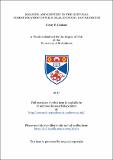Files in this item
Meaning and context in the gestural communication of wild bilia (bonobo: Pan paniscus)
Item metadata
| dc.contributor.advisor | Byrne, Richard W. | |
| dc.contributor.author | Graham, Kirsty Emma | |
| dc.coverage.spatial | 212 p. | en_US |
| dc.date.accessioned | 2019-09-25T13:33:56Z | |
| dc.date.available | 2019-09-25T13:33:56Z | |
| dc.date.issued | 2017-06-20 | |
| dc.identifier.uri | https://hdl.handle.net/10023/18561 | |
| dc.description.abstract | Studying the communication of our closest living relatives, the great apes, can inform our understanding of language evolution. Great ape gestural communication has been well-documented in captivity, but less so in the wild, with the exception of the chimpanzee. My research on the gestural communication of wild bonobos (at Wamba, Democratic Republic of the Congo) aims to fill one of the gaps in our knowledge. In my thesis, I first describe the gestural repertoire of wild bonobos –the physical form of the gestures that they use. The Wamba communities of wild bonobos use 68 gesture types. I then look at the meaning of gestures by analysing the Apparently Satisfactory Outcome (ASO) that they achieve. Of the gesture types that are suitable for analysis, about half have only one ASO, while the other half achieve multiple ASOs. Where these meanings are ambiguous, with one gesture type achieving multiple ASOs, I look at potential modifiers: syntax-like sequence ordering, and behavioural and interpersonal context. There is no effect of sequence order on the meaning of gestures; rather, the behavioural and interpersonal context explains the apparent ambiguity. Gesture types mean different things in different contexts. Finally, I take my findings and compare them to data from wild chimpanzees at Budongo, Uganda. The gestural repertoire (the physical form of the gestures) overlaps by 88-96%, and many ASOs are achieved by the same gesture types. However, the distribution of gesture types for each ASO is different between species, possibly as a result of different contexts arising from differences in social behaviour. | en_US |
| dc.language.iso | en | en_US |
| dc.publisher | University of St Andrews | |
| dc.subject | Bonobo | en_US |
| dc.subject | Pan paniscus | en_US |
| dc.subject | Gesture | en_US |
| dc.subject | Communication | en_US |
| dc.subject | Meaning | en_US |
| dc.subject.lcc | QL737.P94G8 | |
| dc.subject.lcsh | Bonobo--Behavior | en |
| dc.subject.lcsh | Animal communication | en |
| dc.subject.lcsh | Gesture | en |
| dc.subject.lcsh | Social behavior in animals | en |
| dc.title | Meaning and context in the gestural communication of wild bilia (bonobo: Pan paniscus) | en_US |
| dc.type | Thesis | en_US |
| dc.contributor.sponsor | University of St Andrews | en_US |
| dc.contributor.sponsor | Wenner-Gren Foundation | en_US |
| dc.type.qualificationlevel | Doctoral | en_US |
| dc.type.qualificationname | PhD Doctor of Philosophy | en_US |
| dc.publisher.institution | The University of St Andrews | en_US |
This item appears in the following Collection(s)
Items in the St Andrews Research Repository are protected by copyright, with all rights reserved, unless otherwise indicated.

